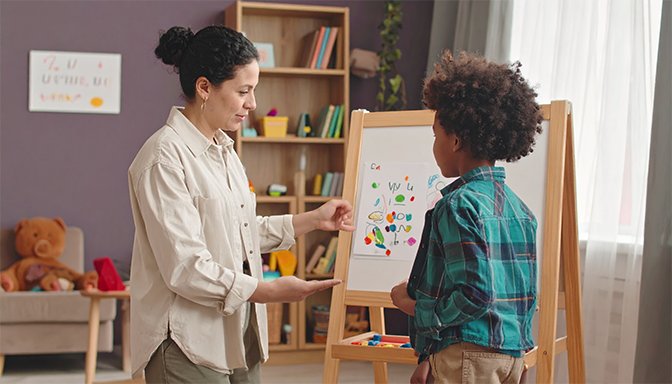5 Smart Ways to Set Boundaries That Actually Work (Without the Power Struggles)
5 Smart Ways for Setting Boundaries with Children That Actually Work
Nothing tests a parent’s sanity quite like a child who seems determined to push every single boundary you’ve ever set. One minute you’re calmly explaining why bedtime is at 8 PM, and the next minute you’re in a full-blown negotiation that somehow escalates into tears, threats, and everyone feeling frustrated. You know boundaries are important for your child’s development and your family’s functioning, but actually enforcing them without constant battles feels impossible some days.
Setting boundaries with children can be a challenging task for any parent, but the rewards are worth the effort.
Here’s what makes boundary-setting so challenging: children are naturally wired to test limits as part of their normal development, but most parents haven’t learned effective strategies for setting and maintaining boundaries without turning every interaction into a power struggle. Traditional approaches often rely on punishment, threats, or authoritarian control that might get compliance in the moment but damage the parent-child relationship and don’t teach children the internal motivation to make good choices.
The good news is that effective boundary-setting, including setting boundaries with children, isn’t about becoming stricter or more controlling – it’s about becoming clearer, more consistent, and more strategic in how you communicate and enforce expectations. When children understand the reasoning behind boundaries and feel respected in the process, they’re much more likely to cooperate and internalize the values you’re trying to teach.
By consistently setting boundaries with children, parents foster a sense of security that is vital for healthy development.
Understanding the Importance of Setting Boundaries with Children
1. Explain the “Why” Behind Your Boundaries in Age-Appropriate Ways

One of the biggest reasons children resist boundaries is that they don’t understand the purpose behind them. When rules feel arbitrary or unfair, children naturally push back because the restrictions don’t make sense from their perspective. Taking time to explain the reasoning behind your expectations helps children understand that boundaries exist for good reasons, not just because you want to control them.
When you start setting boundaries with children, the initial conversations can lay the groundwork for future success.
This doesn’t mean you need to justify every single rule or get into lengthy debates about family expectations. It means providing clear, simple explanations that help children understand how boundaries protect them, help the family function better, or teach important values. When children understand the “why,” they’re more likely to follow rules even when you’re not around to enforce them.
Remember, setting boundaries with children is about nurturing their understanding of respect and responsibility.
Age-appropriate explanations also show respect for your child’s developing reasoning abilities and help them learn to think through the consequences of their choices rather than just following rules blindly.
Effective Boundary Explanations:
- “We have a bedtime because your body needs sleep to grow and learn”
- “We clean up toys so our house is safe and comfortable for everyone”
- “We use respectful words because everyone in our family deserves to be treated kindly”
- “We have screen time limits because too much screen time isn’t healthy for your brain”
- “We wear seatbelts because they keep us safe if there’s an accident”
- “We take turns because it’s fair and helps everyone have fun”
Adjusting Explanations for Different Ages
Young children need simple, concrete explanations focused on safety and fairness. School-age children can understand more complex reasoning about consequences and family values. Teenagers can engage with discussions about personal responsibility and how boundaries prepare them for adult decision-making.
As you navigate setting boundaries with children, it’s essential to adjust your strategies based on their developmental stage.
The key is providing enough explanation to help them understand without getting into power struggles about whether they agree with your reasoning.
2. Set Boundaries Proactively Rather Than Reactively

Many parents find themselves setting boundaries in the heat of the moment when children are already misbehaving or testing limits. This reactive approach often leads to inconsistent rules, harsh consequences delivered in frustration, and children who never know what to expect. Proactive boundary-setting involves establishing clear expectations before problems arise.
When parents start setting boundaries with children early, it helps create a foundation for future interactions.
This means having calm conversations about family rules and expectations during peaceful moments rather than trying to establish boundaries while you’re dealing with challenging behavior. When children know what’s expected of them ahead of time, they’re more likely to succeed and less likely to test limits just to figure out where they are.
Proactive boundary-setting also allows you to involve children in creating family rules and consequences, which increases their buy-in and cooperation. When children help establish expectations, they feel more ownership over following them.
Proactive Boundary-Setting Strategies:
Proactive boundary-setting includes regularly discussing the importance of setting boundaries with children.
- Hold family meetings to discuss and establish household rules together
- Preview expectations before new situations: “When we go to the store, we’ll keep our hands to ourselves and use inside voices”
- Create visual reminders of important rules for younger children
- Practice expected behaviors through role-playing before challenging situations
- Establish routines that build boundary-following into daily life
- Review and adjust family rules periodically as children grow and mature
Making Expectations Clear and Consistent
When boundaries are established proactively, children know what to expect and parents can enforce rules more consistently. This clarity reduces testing behavior because children aren’t trying to figure out where the limits are – they already know.
By clearly communicating why setting boundaries with children is crucial, you foster understanding and cooperation.
Proactive boundary-setting also prevents the emotional reactivity that often happens when parents are trying to establish rules while dealing with misbehavior.
Also, try a large magnetic rewards chart or a digital calendar chore chart to keep expectations and rewards in sight and always accessible.
3. Use Natural Consequences Instead of Arbitrary Punishments

Traditional punishment often creates power struggles because children focus on the unfairness of the consequence rather than learning from their choices. Natural consequences, on the other hand, are directly related to the behavior and help children understand the real-world results of their decisions without parents having to be the “bad guy.”
Natural consequences work because they make sense to children and teach genuine life lessons rather than just compliance through fear. When children experience the logical results of their choices, they learn to make better decisions based on understanding rather than just avoiding punishment.
This approach also preserves the parent-child relationship because you’re not constantly having to punish and control – you’re simply allowing reality to teach important lessons while providing support and guidance.
Implementing natural consequences when setting boundaries with children allows them to learn organically.
Natural Consequence Examples:
- If they don’t put their bike away, it might get damaged by weather (natural consequence) vs. losing TV time (arbitrary punishment)
- If they don’t pack their lunch, they eat what’s available at school vs. getting yelled at about responsibility
- If they spend their allowance impulsively, they don’t have money for something they want later vs. extra chores as punishment
- If they don’t wear a coat, they feel cold vs. losing privileges unrelated to the choice
- If they don’t complete homework, they deal with teacher consequences vs. parent-imposed restrictions
- If they’re rude to friends, friends don’t want to play vs. timeout imposed by parents
Implementing Natural Consequences Supportively
The goal isn’t to let children suffer or learn through harsh experiences, but to allow them to experience the logical results of their choices while providing emotional support and guidance. You can empathize with their disappointment while still allowing them to learn from natural consequences.
Sometimes you’ll need to create logical consequences when natural ones aren’t sufficient or safe, but they should still be directly related to the behavior and focused on learning rather than punishment.
4. Stay Calm and Consistent During Boundary Testing

Children test boundaries not because they’re bad kids, but because testing is how they learn about expectations, safety, and relationships. When parents understand that boundary testing is normal and developmental, they can respond more calmly and consistently rather than taking testing behavior personally or getting into emotional power struggles.
During moments of boundary testing, explaining the reasoning behind setting boundaries with children can mitigate conflicts.
Staying calm during boundary testing is crucial because children are watching how you handle pressure and conflict. When you maintain your composure while consistently enforcing boundaries, you’re teaching them that rules are stable and reliable, not dependent on your mood or their emotional reactions.
Consistency is equally important because children need to know that boundaries are real and dependable. When enforcement varies based on your energy level, mood, or circumstances, children learn to test more frequently to see if this is one of the times when boundaries don’t apply.
Calm Boundary Enforcement Techniques:
- Take deep breaths before responding to testing behavior
- Use a neutral tone when redirecting or enforcing consequences
- Stick to previously established consequences rather than making up new ones in the moment
- Avoid getting drawn into arguments about whether the boundary is fair
- Follow through consistently even when it’s inconvenient for you
- Remember that testing is normal and temporary, not a reflection of your parenting
Maintaining Authority Without Becoming Authoritarian
Calm, consistent boundary enforcement maintains your parental authority while still respecting your child’s emotions and developmental needs. You can be firm about expectations while remaining kind and understanding about their frustration with limits.
It’s important to balance kindness and authority when setting boundaries with children to maintain trust.
The goal is helping children feel secure in your leadership while learning to manage their own emotions around disappointment and limits.
If you’ve ever found yourself raising your voice more than you’d like, you’re not alone. Staying calm when kids push limits is a skill you can practice. The course Raising Resilient Responsible Independent Children walks you through practical, easy-to-use techniques that help you set firm boundaries while keeping your cool, even on the tough days.
5. Involve Children in Problem-Solving When Boundaries Aren’t Working

Sometimes despite your best efforts, certain boundaries continue to be problematic areas that create ongoing conflicts or aren’t working effectively for your family. Instead of just getting stricter or giving up, involve your children in collaborative problem-solving to find solutions that work better for everyone.
Involving kids in discussions around setting boundaries with children encourages accountability.
This approach teaches children valuable problem-solving skills while also increasing their cooperation because they have input into creating solutions. When children help solve boundary problems, they’re more invested in making the solutions work and less likely to continue testing in those areas.
Collaborative problem-solving also shows children that boundaries can be adjusted when there are good reasons, while still maintaining important safety and respect expectations. This flexibility prevents boundaries from becoming rigid control battles while still maintaining necessary structure.
Collaborative Problem-Solving Steps:
- Acknowledge that the current approach isn’t working well for anyone
- Ask for their input: “What’s making this rule hard to follow?” or “What would help you remember this expectation?”
- Brainstorm solutions together that address both their needs and your important concerns
- Try new approaches for a specific time period and evaluate how they’re working
- Adjust solutions based on what you learn, involving children in the evaluation process
- Maintain non-negotiable safety and respect expectations while being flexible about methods
Teaching Life Skills Through Boundary Discussions
When children participate in solving boundary problems, they’re learning crucial life skills like identifying problems, brainstorming solutions, evaluating results, and adjusting approaches based on new information. These skills serve them throughout their lives in relationships, work, and personal challenges.
This collaborative approach also strengthens your relationship because children feel heard and respected while still learning important limits and expectations.
When children help shape the rules around setting boundaries with children, they feel more invested in the outcomes.
Conclusion: Building Cooperation Through Effective Boundaries
Effective boundary-setting isn’t about controlling your children’s every move or getting perfect compliance – it’s about creating clear expectations that help children feel secure while learning important life skills and values. When boundaries are set thoughtfully and enforced consistently with respect for children’s developmental needs, they actually increase cooperation and strengthen family relationships.
By consistently reinforcing the importance of setting boundaries with children, parents can effectively guide behavior.
Remember that learning to follow boundaries is a process that takes time and practice. Children will test limits, make mistakes, and need reminders as they develop self-control and internal motivation. Your patience and consistency during this learning process teaches them that expectations are stable and that you believe in their ability to grow and improve.
The children who develop the strongest internal motivation and self-discipline are often those whose parents learned to set boundaries with clarity, consistency, and respect rather than through control, punishment, or power struggles. The investment you make in effective boundary-setting now pays dividends throughout your child’s development and your lifelong relationship.
Ultimately, setting boundaries with children lays the groundwork for their future independence and decision-making skills.
Your Effective Boundary-Setting Action Plan
-
- Explain the reasoning behind important boundaries in ways your child can understand
Establishing routines that incorporate setting boundaries with children ensures they understand expectations clearly.
-
- Establish expectations proactively during calm moments rather than reacting to misbehavior
- Use natural consequences that teach real-world lessons rather than arbitrary punishments
- Stay calm and consistent when children test boundaries, remembering that testing is normal development
- Involve children in collaborative problem-solving when boundaries aren’t working effectively
Daily interactions around setting boundaries with children can strengthen family bonds and improve communication.
Remember: The goal of boundaries isn’t perfect compliance – it’s helping children develop the internal motivation and skills they need to make good choices throughout their lives while maintaining strong family relationships.
Affiliate Disclaimer: Some links in this article may be affiliate links where a purchase would provide us with a commission. We only recommend products and services we truly believe can help you on your personal growth journey.
Advice Disclaimer: This advice is for informational and entertainment purposes only and not a substitute for professional counseling, therapy, financial, legal, or medical advice. You are responsible for your own decisions and actions. For serious issues, please consult qualified professionals.



